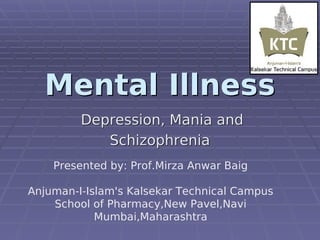The document discusses mental illnesses such as depression, mania, and schizophrenia. It defines depression as a medical condition that affects mood and lists common signs like persistent sadness, sleep issues, appetite changes, fatigue, and thoughts of death. Depression is caused by biological, genetic, environmental, and psychological factors and impacts serotonin levels in the brain. Treatment includes medication like SSRIs that prolong serotonin activity, as well as teaching coping skills. Mania involves heightened energy and activity as part of bipolar disorder, alternating with depression. The causes of mania may involve neurotransmitter imbalances.

































